Nucor Bundle
Can Nucor's Growth Strategy Continue to Dominate the Steel Industry?
Nucor Corporation, a titan in the steel industry, has consistently demonstrated how strategic foresight can reshape a company's destiny. From its humble beginnings, Nucor has evolved into North America's largest steel producer, a testament to its innovative approach. This analysis delves into Nucor's Nucor SWOT Analysis, growth strategy, and future prospects.
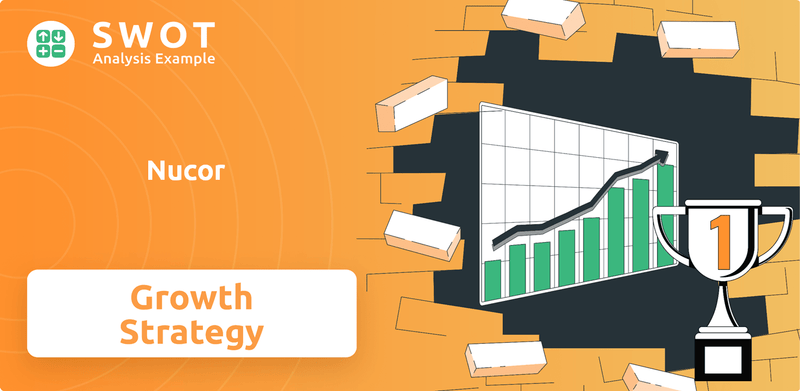
Understanding Nucor's journey is crucial for investors and strategists alike. This piece will explore the company's competitive advantage, examining how it has navigated steel industry trends and maintained impressive financial performance. We'll also examine Nucor's expansion plans in 2024 and beyond, providing insights into its long-term growth potential and how it tackles challenges in the evolving market.
How Is Nucor Expanding Its Reach?
The company is actively pursuing a multi-year organic growth pipeline and strategic acquisitions to expand its business and diversify its product offerings. This approach is a key component of its overall Nucor growth strategy, focusing on entering new markets and enhancing its market reach. The company's strategic initiatives are designed to capitalize on emerging opportunities and strengthen its position in the steel industry.
A significant focus of the company's expansion efforts is on the rapidly growing data center infrastructure sector. This strategic move allows the company to diversify its revenue streams and tap into a high-growth market. Through acquisitions and internal investments, the company aims to provide comprehensive solutions for data center buildings, moving beyond simply selling products.
The company's Nucor future prospects are closely tied to its ability to execute its expansion plans effectively. These plans include both organic growth projects and strategic acquisitions, all aimed at increasing its market share and profitability. By investing in new technologies and expanding its product portfolio, the company is positioning itself for long-term success in a dynamic market environment.
The company is heavily investing in the data center market. This includes acquiring companies like Southwest Data Products, Inc. (SWDP) in April 2024 for $115 million. The company has also launched Nucor Data Systems to better serve this industry. This expansion is a key part of its diversification strategy.
Acquisitions like C.H.I. and Rytec (acquired June 2024) have broadened the company's product offerings. These moves enable the company to provide comprehensive solutions, moving from selling individual products to offering complete systems. This strategy enhances its market competitiveness.
The company's capital expenditure plan for 2025 is approximately $3.0 billion. A substantial 65% of this amount is allocated to enhancing product capabilities and expansion projects. This significant investment underscores the company's commitment to growth and innovation.
Key projects include a new sheet mill in West Virginia, expected to be completed by the end of 2026. The announcement of a rebar micro mill in the Pacific Northwest in February 2024, with completion expected in two years, further demonstrates its commitment to expanding its production capacity. These projects are designed to meet growing market demands.
The company is expanding its Towers & Structures business unit. This includes a new utility structures manufacturing facility in Indiana, expected to start production by mid-2025, following a $115 million investment. A third facility in Utah, with a $200 million investment, is also planned.
- These initiatives are driven by the need to access new customers and diversify revenue streams.
- The company aims to capitalize on megatrends such as reshoring and the demand for a more robust energy grid.
- The expansion in utility structures is designed to meet the growing demand for utility infrastructure in the western U.S.
- The strategic acquisitions and capital projects demonstrate the company's commitment to long-term growth and market leadership.
These expansion initiatives are crucial for the company's long-term success. For a deeper dive into the company's marketing strategies, consider reading the Marketing Strategy of Nucor. These investments and strategic moves will help the company navigate steel industry trends and maintain its Nucor competitive advantage.
Nucor SWOT Analysis
- Complete SWOT Breakdown
- Fully Customizable
- Editable in Excel & Word
- Professional Formatting
- Investor-Ready Format
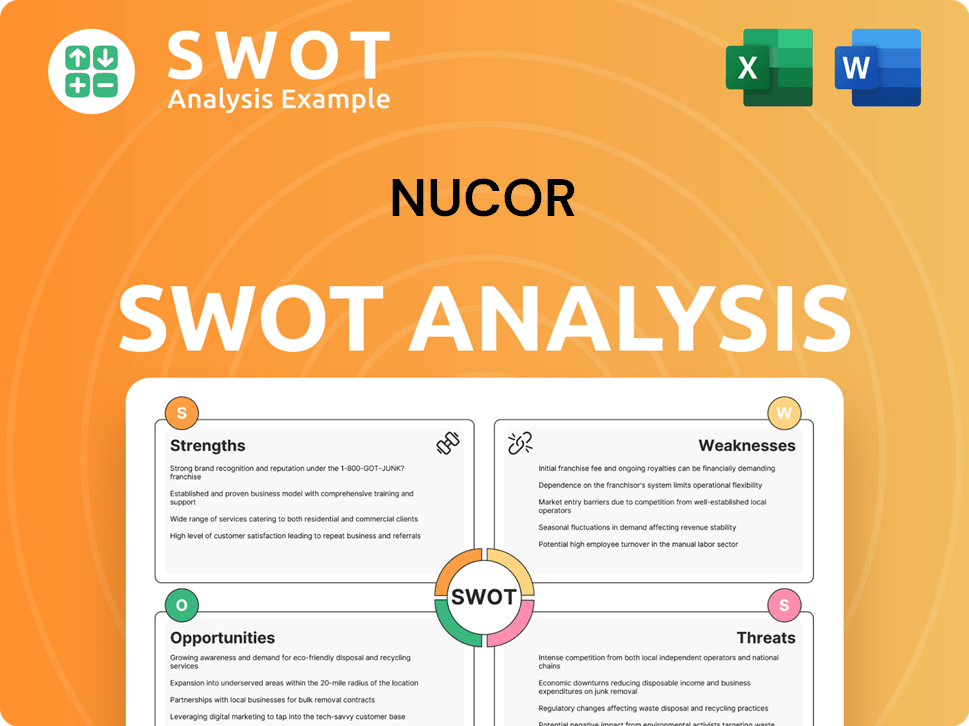
How Does Nucor Invest in Innovation?
The company's approach to innovation and technology is a cornerstone of its Nucor growth strategy, focusing on enhancing efficiency, reducing costs, and improving product quality. This commitment involves significant investments in research and development, as well as collaborations with external innovators. These efforts are crucial for maintaining its Nucor competitive advantage in the evolving steel industry trends.
Nucor's strategic initiatives also include a strong emphasis on sustainability. The company is actively working towards net-zero steel production and has a science-based plan for reducing greenhouse gas emissions. This commitment not only addresses environmental concerns but also positions the company as a leader in clean steel solutions, catering to the changing needs of its customers. This focus is essential for understanding Nucor's future prospects.
A key element of Nucor's innovation strategy is its commitment to digital transformation. This includes investments in automation, artificial intelligence (AI), and robotic well cells. These technologies are designed to enhance safety, improve cost efficiency, and boost operational effectiveness across all its business units. This is a key part of the overall Nucor company analysis.
Nucor invests heavily in R&D to drive innovation. This includes internal projects and collaborations with external partners, such as universities and other companies. These investments are crucial for staying ahead of steel industry trends and enhancing its Nucor competitive advantage.
The company is focused on digital transformation, implementing automation, AI, and robotics. These technologies improve efficiency, reduce costs, and enhance safety. These initiatives are crucial for the company's operational effectiveness and its ability to compete in the market.
Nucor is committed to net-zero steel production and has a detailed plan for reducing emissions. This includes partnerships for carbon capture and storage and exploring new technologies like electrolysis for iron ore. These efforts are integral to Nucor's long-term growth and environmental responsibility.
Nucor is partnering with ExxonMobil on carbon capture and storage projects. This partnership, located at its direct reduced iron (DRI) manufacturing site in Convent, Louisiana, aims to remove up to 800,000 metric tons of CO2 per year. This is a significant step towards reducing its carbon footprint.
Nucor is exploring the use of nuclear technology to power its steel mills. The goal is to use on-site or near-site nuclear small modular reactors by the end of this decade. This initiative could significantly reduce its reliance on fossil fuels.
The company is also investigating electrolysis processes for iron ore. This technology could provide a cleaner and more sustainable method of steel production. This is another example of Nucor's commitment to innovation and environmental responsibility.
Nucor strategically partners with other companies and universities to advance its technological capabilities. These partnerships focus on areas like carbon capture, renewable energy, and advanced manufacturing processes. These collaborations are essential for driving innovation and maintaining its competitive edge.
- Partnerships with companies like ExxonMobil for carbon capture and storage.
- Investments in new technologies, such as small modular reactors for nuclear power.
- Collaborations with universities for research and development.
- Focus on expanding carbon-free energy options.
Nucor PESTLE Analysis
- Covers All 6 PESTLE Categories
- No Research Needed – Save Hours of Work
- Built by Experts, Trusted by Consultants
- Instant Download, Ready to Use
- 100% Editable, Fully Customizable
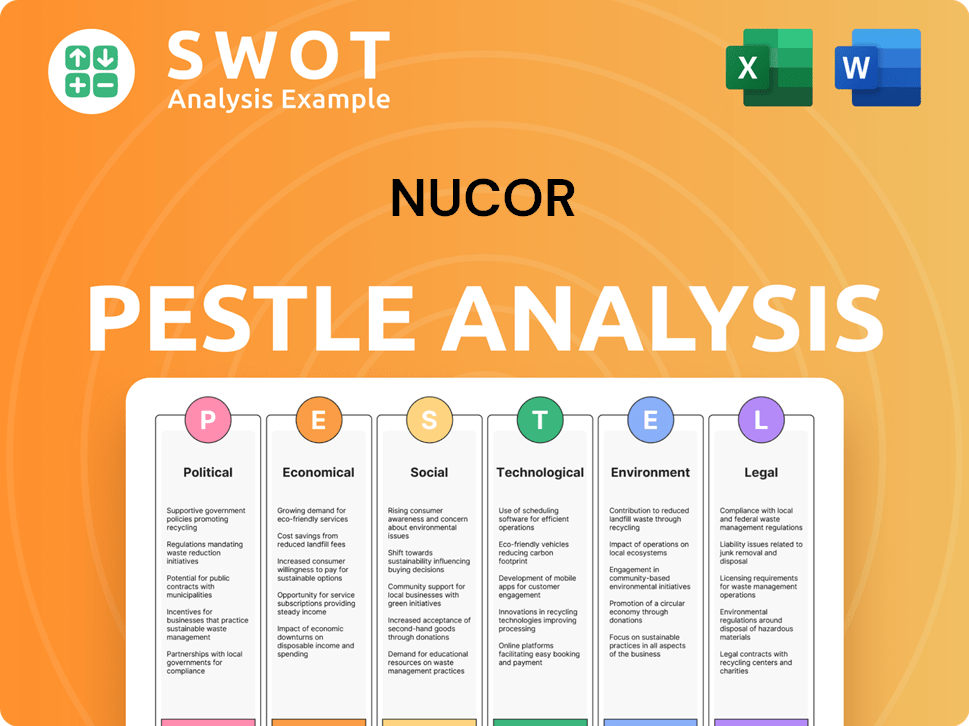
What Is Nucor’s Growth Forecast?
The financial outlook for Nucor reflects a dynamic environment in the steel industry. The company's performance in early 2025 indicates both challenges and strengths, shaped by broader steel industry trends. Analyzing Nucor's financial performance provides insights into its strategic positioning and future prospects.
For the first quarter of 2025, Nucor reported consolidated net sales of $7.83 billion. This represents an 11% increase from the fourth quarter of 2024, but a 4% decrease compared to the first quarter of 2024. Net earnings attributable to Nucor stockholders for Q1 2025 were $156 million, or $0.67 per diluted share, a decline from $287 million in Q4 2024 and significantly lower than $785 million in Q4 2023. The net profit margin for the quarter ending March 31, 2025, was 4.38%, a sequential deterioration to 2.89% due to increased costs and taxes despite revenue increases. Understanding these figures is crucial for a comprehensive Nucor company analysis.
Despite these pressures, Nucor maintains a strong financial position, with $4.06 billion in cash and cash equivalents as of March 31, 2025. The company’s projected capital expenditure for 2025 remains at approximately $3.0 billion, demonstrating a continued commitment to growth projects. Nucor returned approximately $2.7 billion to shareholders in 2024 through dividends and share repurchases, with a commitment to return a minimum of 40% of net earnings to shareholders over time. For further insights into Nucor's market positioning, consider exploring the Target Market of Nucor.
Nucor's revenue for Q1 2025 was $7.83 billion, showing an increase from Q4 2024 but a decrease compared to Q1 2024. Net earnings for Q1 2025 were $156 million, a significant drop from previous quarters. These figures highlight the impact of steel industry trends.
Nucor held $4.06 billion in cash and cash equivalents as of March 31, 2025. The company plans to spend around $3.0 billion on capital expenditures in 2025. This demonstrates Nucor's commitment to long-term growth.
In 2024, Nucor returned approximately $2.7 billion to shareholders through dividends and share repurchases. The company aims to return at least 40% of its net earnings to shareholders. This reflects Nucor's commitment to shareholder value.
Analysts project a profit of $7.94 per share for fiscal 2025, a decrease from $8.90 in fiscal 2024. However, a rebound is anticipated in 2026, with a projected 36.9% year-over-year growth to $10.87. These forecasts offer insights into Nucor's future prospects.
Nucor's long-term financial goals involve strengthening its core steel business and expanding into steel-adjacent markets. This strategy is supported by strategic investments and operational efficiency, which are key components of the Nucor growth strategy.
- Focus on core steel business.
- Expansion into steel-adjacent markets.
- Strategic investments for growth.
- Operational efficiency improvements.
Nucor Business Model Canvas
- Complete 9-Block Business Model Canvas
- Effortlessly Communicate Your Business Strategy
- Investor-Ready BMC Format
- 100% Editable and Customizable
- Clear and Structured Layout
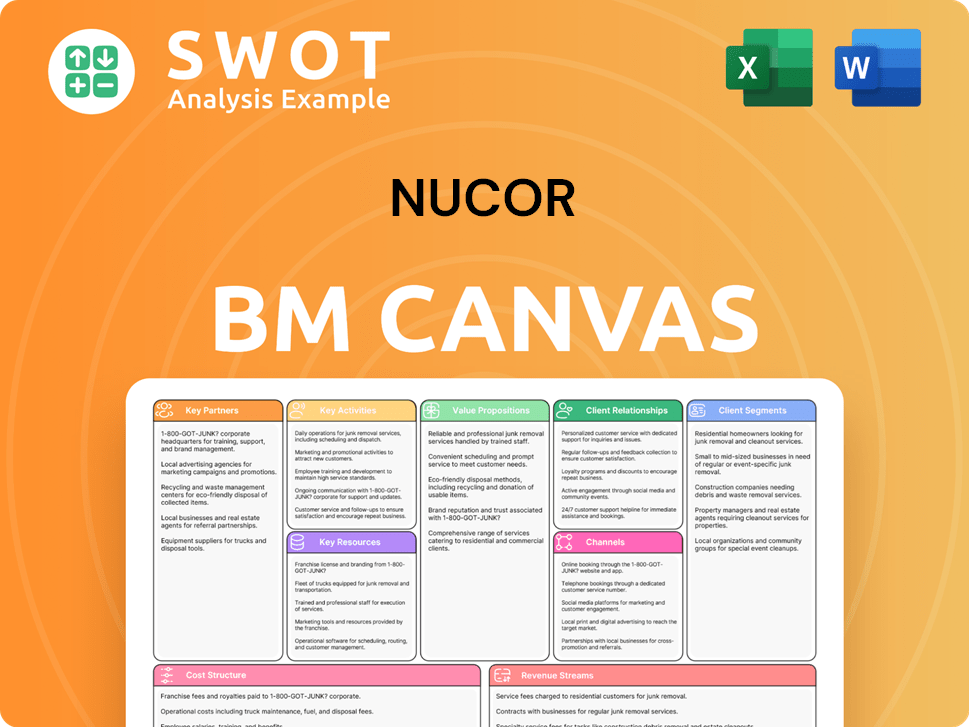
What Risks Could Slow Nucor’s Growth?
The path to growth for Nucor, like any major player in the steel sector, is paved with potential risks and obstacles. Understanding these challenges is crucial for assessing the company's future prospects and its capacity to maintain its position in the market. Several factors, from economic cycles to global competition, could significantly impact Nucor's strategic initiatives and financial performance.
One of the primary challenges facing Nucor is the inherent cyclical nature of the steel industry. Economic downturns can lead to decreased demand, resulting in volatile pricing and reduced profitability. Moreover, the steel industry trends, including global overcapacity and fluctuating raw material costs, pose additional risks. The company must navigate these complexities to sustain its competitive advantage and achieve its long-term growth potential.
The company faces several risks that could impact its growth ambitions. A major concern is the cyclical nature of the steel industry, which can lead to volatile pricing. For instance, hot-rolled coil (HRC) prices, which spiked earlier in 2025, have since retreated due to softening demand and competitive market conditions.
The steel industry is highly sensitive to economic cycles. Downturns can reduce demand and lead to price volatility. For example, in early 2025, HRC prices saw fluctuations, which impacted Nucor's financial performance. Understanding and adapting to these cycles is crucial for Nucor's strategic initiatives.
Overcapacity, particularly from China, increases import competition and puts downward pressure on U.S. steel prices. This can affect Nucor's market share in North America and its overall profitability. Nucor must continuously assess and adjust to global market dynamics to compete effectively.
The price and availability of raw materials, such as scrap steel, can fluctuate significantly. Although Nucor mitigates this risk through investments in direct reduced iron (DRI) production and scrap brokerage services, it remains a key factor. Managing supplier relationships is essential for cost control.
Changes in environmental laws, trade policies, and tariffs can reshape the competitive landscape. These factors can influence Nucor's cost structure and market access. Nucor must stay informed and adapt to these regulatory shifts to maintain its competitive advantage.
Cybersecurity incidents pose a growing risk, as seen in May 2025, when a cybersecurity incident forced Nucor to halt production at some facilities. This highlights the need for robust security measures. Cyberattacks can disrupt operations and negatively impact the company's financial performance.
A key end market for steel is the automotive industry. Stagnation in automotive demand could lead to decreased sales for Nucor. Nucor needs to diversify its offerings and market presence to mitigate this risk. This will help to ensure long-term growth potential.
To address these risks, Nucor employs several strategies. These include diversification of product offerings and market presence, and maintaining a diversified supply chain. The company’s flexible electric arc mini-mill technology also helps it adjust production based on demand changes, helping to maintain margins through various economic cycles. These are all key components of Nucor's Revenue Streams & Business Model of Nucor.
Nucor's ability to compete with competitors depends on its ability to manage costs, adapt to market changes, and innovate. Factors such as global steel production overcapacity and the impact of tariffs on Nucor's business are key considerations in this competitive environment. Nucor's financial performance is also crucial.
Nucor Porter's Five Forces Analysis
- Covers All 5 Competitive Forces in Detail
- Structured for Consultants, Students, and Founders
- 100% Editable in Microsoft Word & Excel
- Instant Digital Download – Use Immediately
- Compatible with Mac & PC – Fully Unlocked
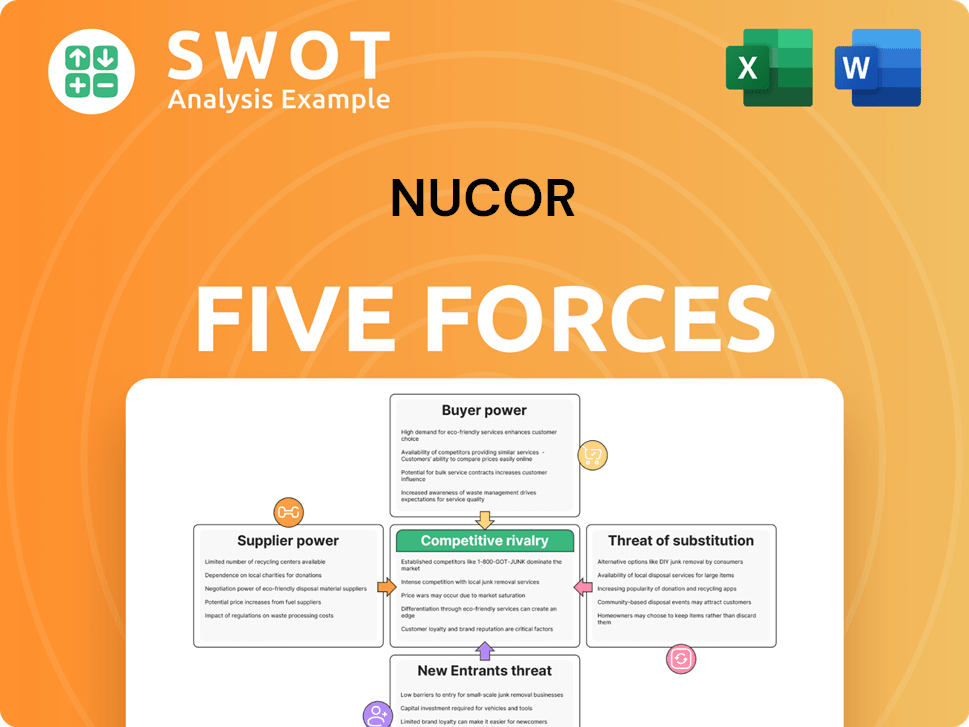
Related Blogs
- What are Mission Vision & Core Values of Nucor Company?
- What is Competitive Landscape of Nucor Company?
- How Does Nucor Company Work?
- What is Sales and Marketing Strategy of Nucor Company?
- What is Brief History of Nucor Company?
- Who Owns Nucor Company?
- What is Customer Demographics and Target Market of Nucor Company?
Disclaimer
All information, articles, and product details provided on this website are for general informational and educational purposes only. We do not claim any ownership over, nor do we intend to infringe upon, any trademarks, copyrights, logos, brand names, or other intellectual property mentioned or depicted on this site. Such intellectual property remains the property of its respective owners, and any references here are made solely for identification or informational purposes, without implying any affiliation, endorsement, or partnership.
We make no representations or warranties, express or implied, regarding the accuracy, completeness, or suitability of any content or products presented. Nothing on this website should be construed as legal, tax, investment, financial, medical, or other professional advice. In addition, no part of this site—including articles or product references—constitutes a solicitation, recommendation, endorsement, advertisement, or offer to buy or sell any securities, franchises, or other financial instruments, particularly in jurisdictions where such activity would be unlawful.
All content is of a general nature and may not address the specific circumstances of any individual or entity. It is not a substitute for professional advice or services. Any actions you take based on the information provided here are strictly at your own risk. You accept full responsibility for any decisions or outcomes arising from your use of this website and agree to release us from any liability in connection with your use of, or reliance upon, the content or products found herein.